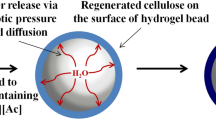Abstract
The formation and smooth recovery of ibuprofen encapsulated in microcapsules using gelatin and carboxymethyl cellulose (CMC) complex coacervation without glutaraldehyde were the objectives of this investigation. The microcapsules were recovered as ionically cross-linked beads using aqueous ferric chloride in 50 vol.% of 2-propanol. A physical mixture of CMC/gelatin (FP1) and CMC alone (FP2) beads was also prepared for comparison. The drug-entrapment efficiency of complex coacervate beads (FP3-FP5) was dependent on the drug-to-polymer ratio and was in the range of 86–92 mass %. Beads prepared with the highest ratio of the drug (FP5) exhibited the lowest entrapment. FP1 and FP2 beads exhibited an entrapment efficiency of 98.5 mass % and 91.3 mass %, respectively. Infrared spectroscopy (FTIR) revealed different functional groups in complex coacervate, physical mixture and FP2 beads. Optical and scanning electron microscopy revealed the distinct appearance and surface morphology of the various beads. The stable and crystalline nature of ibuprofen in the beads was confirmed by FTIR and differential scanning calorimetry (DSC), respectively. Ibuprofen release from FP1 and FP2 beads was very slow and unsuitable for oral delivery. The bead prepared by complex coacervation (FP5) showed a better release profile over 48 h and could be developed as a sustained drug delivery system.
Similar content being viewed by others
References
Barbucci, R., Magnani, A., & Consumi, M. (2000). Swelling behavior of carboxymethylcellulose hydrogels in relation to cross-linking, pH, and charge density. Macromolecules, 33, 7475–7480. DOI: 10.1021/ma0007029.
Buhus, G., Peptu, C., Popa, M., & Desbrières, J. (2009). Controlled release of water soluble antibiotics by carboxymethylcellulose- and gelatin-based hydrogels crosslinked with epichlorohydrin. Cellulose Chemistry and Technology, 43, 141–151.
Buzzi, V., Brudner, M., Wagner, T. M., Bazzo, G. C., Pezzin, A. P. T., & Silva, D. A. K. (2013). Caboxymetylcellulose/gelatin blends loaded with piroxicam: Preparation, characterization and evaluation of in vitro release profile. Journal of Encapsulation and Adsorption Sciences, 3, 99–107. DOI: 10.4236/jeas.2013.34012.
Charpentier-Valenza, D., Merle, L., Mocanu, G., Picton, L., & Muller, G. (2005). Rheological properties of hydrophobically modified carboxymethylcelluloses. Carbohydrate Polymers, 60, 87–94. DOI: 10.1016/j.carbpol.2004.11.030.
Costa, P., & Lobo, J. M. S. (2001). Modeling and comparison of dissolution profiles. European Journal of Pharmaceutical Sciences, 13, 123–133. DOI: 10.1016/s0928-0987(01)00095-1.
Deasy, P. B. (1984). Microencapsulation and related drug processes (Series: Drugs and the pharmaceutical sciences, Vol. 20). New York, NY, USA: Marcel Dekker.
Devi, N., & Maji, T. K. (2009). Preparation and evaluation of gelatin/sodium carboxymethyl cellulose polyelectrolyte complex microparticles for controlled delivery of isoniazid. AAPS PharmSciTech, 10, 1412–1419. DOI: 10.1208/s12249-009-9344-9.
Devi, N., & Maji, T. K. (2011). Study of complex coacervation of gelatin A with sodium carboxymethyl cellulose: Microencapsulation of neem (Azadirachta indica A. Juss.) seed oil (NSO). International Journal of Polymeric Materials, 60, 1091–1105. DOI: 10.1080/00914037.2011.553851.
Garrigues, S., Gallignani, M., & de la Guardia, M. (1993). FIA-FT-IR determination of ibuprofen in pharmaceuticals. Talanta, 40, 89–93. DOI: 10.1016/0039-9140(93)80145-h.
Lii, C. Y., Tomasik, P., Zaleska, H., Liaw, S. C., & Lai, V. M. F. (2002). Carboxymethyl cellulose-gelatin complexes. Carbohydrate Polymers, 50, 19–26. DOI: 10.1016/s0144-8617(01)00372-1.
Muyonga, J. H., Cole, C. G. B., & Duodu, K. G. (2004). Fourier transform infrared (FTIR) spectroscopic study of acid soluble collagen and gelatin from skins and bones of young and adult Nile perch (Lates niloticus). Food Chemistry, 86, 325–332. DOI: 10.1016/j.foodchem.2003.09.038.
Prasad, M. P., & Kalyanasundaram, M. (1992). Iron(III) carboxymethylcelluose as swellable erodible matrix for the controlled release of a mosquito larvicide. Journal of Controlled Release, 22, 167–172. DOI: 10.1016/0168-3659(92)90201-2.
Prasad, M. P., & Kalyanasundaram, M. (1993). Ionotropic crosslinking of sodium carboxymethylcellulose and sodium carboxymethylcellulose-gelatin matrices and their erosion properties. Journal of Applied Polymer Science, 49, 2075–2079. DOI: 10.1002/app.1993.070491203.
Rokhade, A. P., Agnihotri, S. A., Patil, S. A., Mallikarjuna, N. N., Kulkarni, P. V., & Aminabhavi, T. M. (2006). Semiinterpenetrating polymer network microspheres of gelatin and sodium carboxymethyl cellulose for controlled release of ketorolac tromethamine. Carbohydrate Polymers, 65, 243–252. DOI: 10.1016/j.carbpol.2006.01.013.
Saravanan, M., Bhaskar, K., Srinivasa Rao, G., & Dhanaraju, M. D. (2003). Ibuprofen-loaded ethylcellulose/polystyrene microspheres: An approach to get prolonged drug release with reduced burst effect and low ethylcellulose content. Journal of Microencapsulation, 20, 289–302. DOI: 10.3109/02652040309178070.
Saravanan, M., & Panduranga Rao, K. (2010). Pectin-gelatin and alginate-gelatin complex coacervation for controlled drug delivery: Influence of anionic polysaccharides and drugs being encapsulated on physicochemical properties of microcapsules. Carbohydrate Polymers, 80, 808–816. DOI: 10.1016/j.carbpol.2009.12.036.
Saravanan, M., Thenapakiam, S., Anand, K. V., & Pushpamalar, J. (2015). Dual cross-linked carboxymethyl sago pulpgelatine complex coacervates for sustained drug delivery. Polymers, 7, 1088–1105. DOI: 10.3390/polym7061088.
Silverstein, R. M., & Webster, F. X. (1998). Spectrometric identification of organic compounds (6th ed.). Hoboken, NJ, USA: Wiley.
Wang, M., Xu, L., Hu, H., Zhai, M., Peng, J., Nho, Y., Li, J., & Wei, G. (2007). Radiation synthesis of PVP/CMC hydrogels as wound dressing. Nuclear Instruments and Methods in Physics Research, Section B: Beam Interactions with Materials and Atoms, 265, 385–389. DOI: 10.1016/j.nimb.2007.09.009.
Author information
Authors and Affiliations
Corresponding author
Rights and permissions
About this article
Cite this article
Huei, G.O.S., Muniyandy, S., Sathasivam, T. et al. Iron cross-linked carboxymethyl cellulose—gelatin complex coacervate beads for sustained drug delivery. Chem. Pap. 70, 243–252 (2016). https://doi.org/10.1515/chempap-2015-0197
Received:
Revised:
Accepted:
Published:
Issue Date:
DOI: https://doi.org/10.1515/chempap-2015-0197




